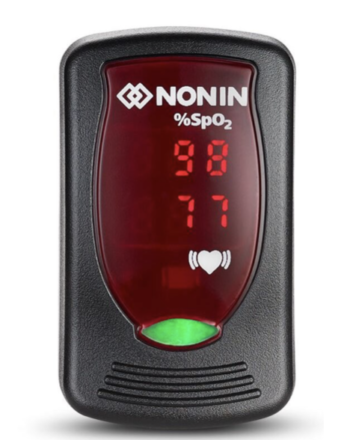
Powerful TECC/TCCC uses for a fingertip pulse oximeter
- Posted by Mike Shertz MD/18D
- Categories (C) Circulation
🕖 Reading Time, 5 minutes
BLUF*: For the pulse oximeter’s O2 saturation reading to be valid, the device must also be consistently identifying the patient’s pulse. If the pulse waveform or notation isn’t steady, the oxygen reading isn’t valid.
Fingertip oxygen saturation monitors are small, lightweight (most weighing less than 2 ounces), and convenient ways to monitor a causality’s oxygen saturation in tactical and austere environments.
The convenience of placing a small monitor on a casualty’s finger and rapidly determining their heart rate and O2 saturation is compelling. Blast-lung type injuries and clinically significant pneumothorax is much easier to diagnose if you know the casualty’s oxygen levels are low.
In a mass casualty event, an untrained rescuer could help triage efforts by moving from victim to victim, calling out heart rates and saturations to a trained provider, markedly increasing awareness on who might need care next.
However, like any piece of equipment, you need to know how to use it and when it fails.
Oxygen saturation is determined by shining red and infrared light through the arterial blood in a finger. Light absorption between oxygenated and unoxygenated blood is different. Specifically, hemoglobin, the protein on red blood cells that binds oxygen, absorbs more infrared light but allows red light to pass through. Deoxygenated hemoglobin does the opposite. This allows the monitor to determine what percentage of the patient’s arterial hemoglobin is actually carrying oxygen. Normally, with healthy lungs, it should be 97 to 100%.
By only measuring arterial blood flow, the monitor also determines the casualty’s heart rate. This can lead to erroneous readings if the monitor has difficulty identifying the patient’s finger arterial flow because of hypoperfusion, vasoconstriction, a highly calloused finger, and fingernail polish, skin pigmentation, movement, etc.
If the monitor isn’t consistently identifying the patient’s pulse, the oxygen saturation generated can’t be relied upon as accurate. Some higher quality monitors have built-in filters to assist in reading arterial flow in these challenging environments. Low quality and inexpensive monitors will give highly inaccurate readings in these situations if they give any reading at all.
Even if the fingertip pulse oximeter is reading correctly, you need to know the device’s accuracy. The FDA considers the Nonin 9550 finger pulse oximeter to be the gold standard fingertip device. Nonin developed this technology over 25 years ago. It is made in the USA and the only fingertip device approved by the US military for use on aircraft, if that matters to you. (Note: The Nonin 9590 is the civilian version of the 9550, as recommended by Nonin. It is substantially cheaper, but unless you need a military aircraft worthiness rating, it is functionally the same.)
Even this professional-grade fingertip oximeter reads + or – 2%. Though this may not seem much of an issue, an O2 saturation reading of 95% might actually be a saturation of 93% or 97%. The first is low and concerning while the other is entirely normal. Despite that, these devices provide insight into a casualty’s oxygenation status in a way physical observation can’t.
Many commercial models are not UL-approved as medical devices, but rather for “sports use.” These devices are much less accurate. Even some “FDA approved” medical devices lack adequate accuracy.
As the popularity of these fingertip monitors has increased with the presence of Covid in the community, we routinely see people noting unreliable readings on cheap Amazon-bought fingertip pulse oximeters. We have repeatedly advised against buying medical devices and life-saving tools on Amazon due to the prevalence of unreliable and counterfeit products.
If you are going to make medical management decisions based on the pulse-ox reading, it should be from one officially approved as a medical device with known accuracy. As always, you should be treating the patient, not the device, but a reliable O2 saturation monitor can help you make management decisions faster and more reliably.
*For those unfamiliar with this term, BLUF is “Bottom Line Up Front,”
Interested to learn more? Try our online courses, or get started with a sample of the material in the preview course
Preview CourseNot sure? Try a preview TRAIN NOWOnline Tactical Casualty Care Classes
Dr. Mike Shertz is the Owner and Lead Instructor at Crisis Medicine. Dr. Shertz is a dual-boarded Emergency Medicine and EMS physician, having spent over 30 years gaining the experience and insight to create and provide his comprehensive, science-informed, training to better prepare everyday citizens, law enforcement, EMS, and the military to manage casualties and wounded in high-risk environments. Drawing on his prior experience as an Army Special Forces medic (18D), two decades as an armed, embedded tactical medic on a regional SWAT team, and as a Fire Service and EMS medical director.
Using a combination of current and historical events, Dr. Shertz’s lectures include relevant, illustrative photos, as well as hands-on demonstrations to demystify the how, why, when to use each emergency medical procedure you need to become a Force Multiplier for Good.



